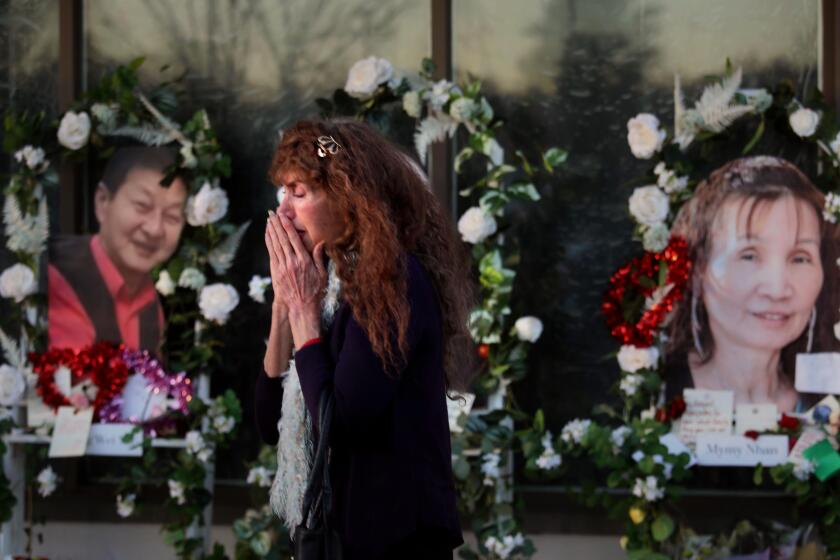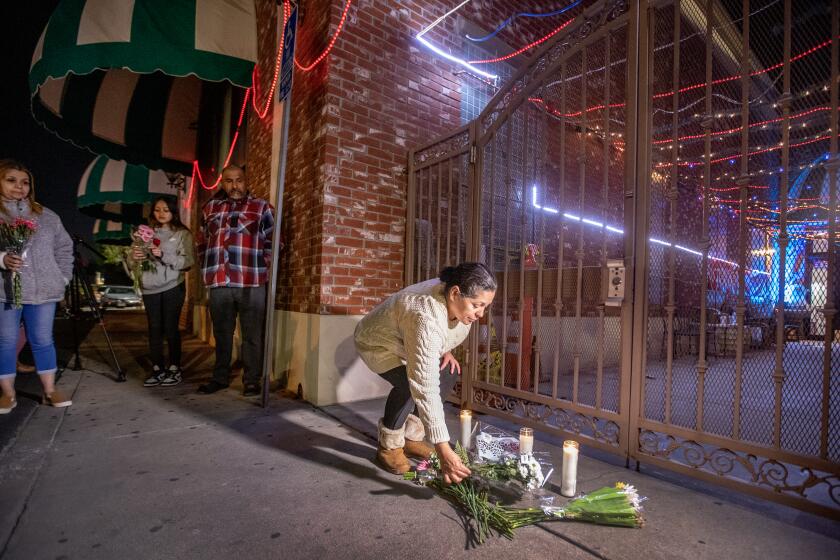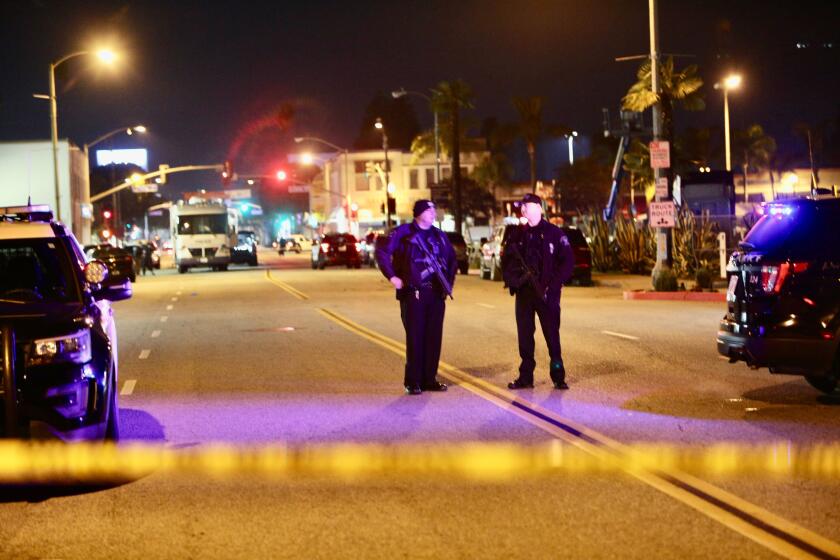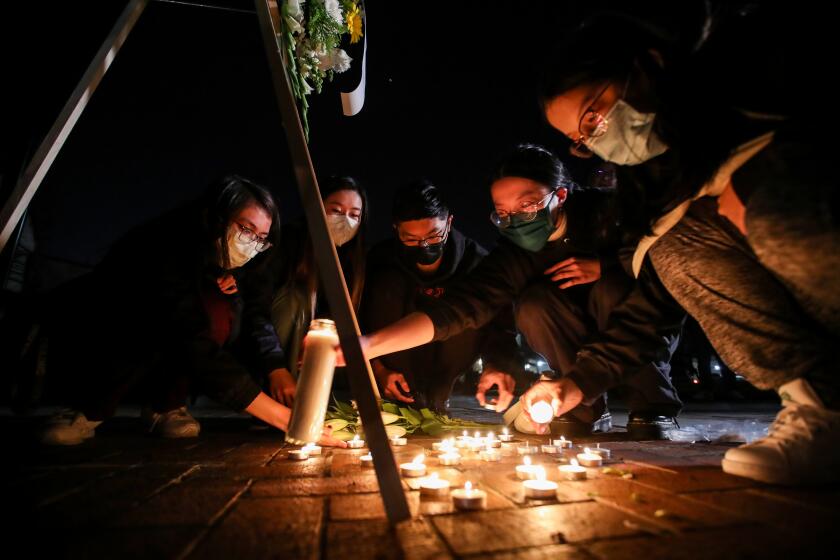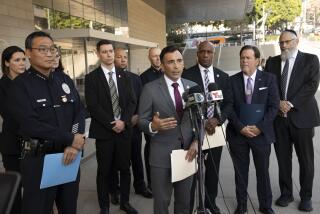Why police took hours to warn public that Monterey Park mass shooter was on the loose
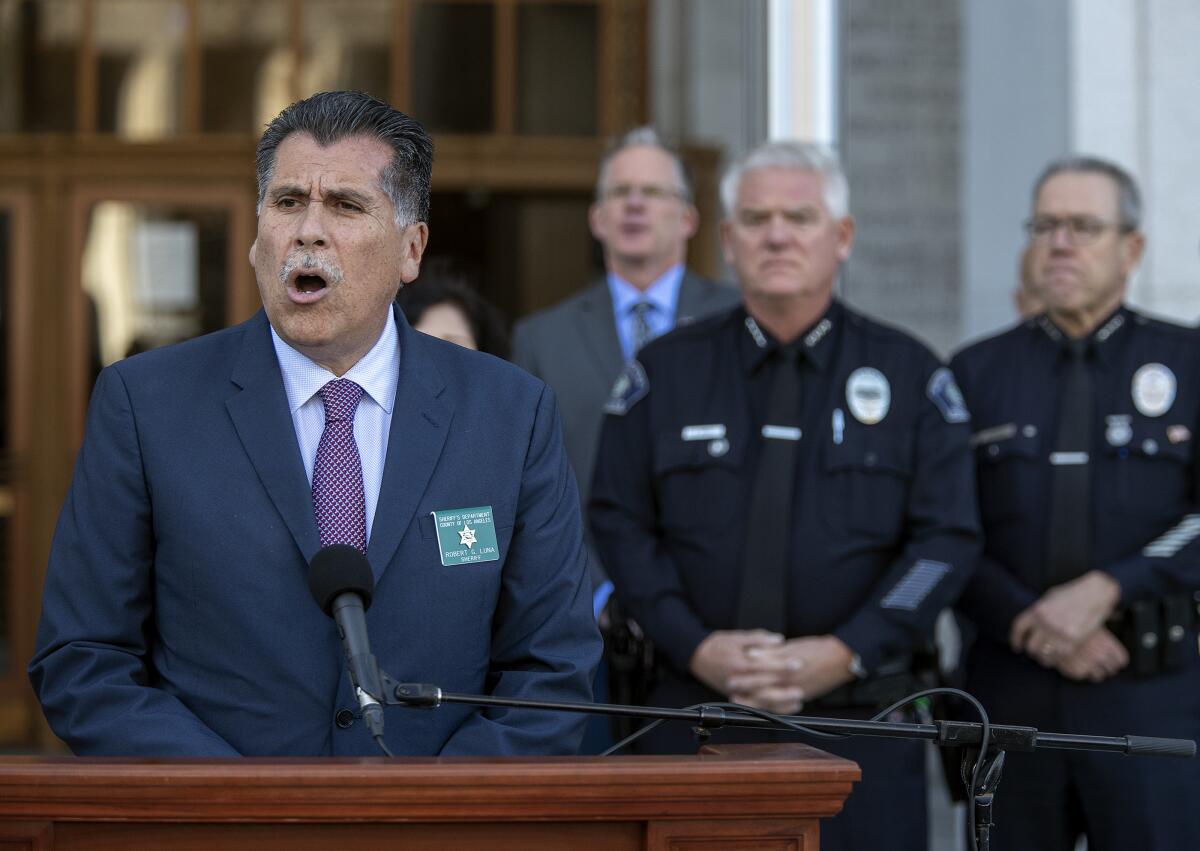
- Share via
As the investigation into the Monterey Park mass shooting continues, police officials are facing scrutiny over how long it took them to notify the public that the gunman was still on the loose.
For roughly five hours after 72-year-old Huu Can Tran opened fire inside Star Ballroom Dance Studio on West Garvey Avenue and fled late Saturday night, Monterey Park and Los Angeles County authorities made no announcements about the gunman’s location.
Instead, the death toll and the gunman’s escape in the chaos was revealed through government sources in other agencies and radio broadcasts.
Authorities say Tran opened fire about 10:20 p.m. Saturday, killing 11 and wounding nine other people. The first 911 calls were made about 10:22 p.m., and police arrived at the studio within four minutes.
About 20 minutes after the rampage in Monterey Park, the shooter walked into Lai Lai Ballroom & Studio in nearby Alhambra. Brandon Tsay, 26, confronted him in the studio’s lobby and wrested a semiautomatic MAC-10 assault weapon away from Tran before watching him flee in a white van.
The shooting — one of the worst in Los Angeles County history — unfolded on the eve of Lunar New Year, just hours after the streets in Monterey Park had been filled with thousands of revelers celebrating one of the largest holiday events in the region.
Three mass shootings have been carried out in one week in California, in Goshen, Monterey Park and Half Moon Bay.
L.A. County Sheriff Robert Luna said during a news conference Monday that in the hours following the shooting, authorities were trying to weigh assisting victims, investigating the scene and apprehending the suspect.
“When we started putting out public information, the priority was to get this person into custody, so we were very strategic in the way we were putting out information,” he said. “Ultimately, it worked.”
At 2:48 a.m., the Los Angeles County Sheriff’s Information Bureau issued an advisory confirming fatalities and noting the suspect was a man. But the alert didn’t mention he was not in custody.
Official notification came around 3:30 a.m. — about five hours after Tran opened fire inside the dance hall — during a news conference. L.A. County Sheriff’s Capt. Andrew Meyer told reporters the “suspect fled the scene and remains outstanding.”
A gunman opened fire at a dance studio in Monterey Park, killing 11 people and wounding 9 more. Tens of thousands had gathered earlier nearby for a Lunar New Year festival.
Horace Frank, a former assistant chief at the Los Angeles Police Department, said typically an agency’s first inclination would be to notify the public when a mass shooter is at large.
“It is a public safety issue,” he said. “The only time you don’t do that is when you can articulate specific reasons otherwise. You always err on the side of keeping the public informed.”
Frank, who oversaw counter-terrorism and tactical operations at LAPD, said in this case, “if there is a reason for delay, I cannot think of one.”
At 11:20 a.m. Sunday, sheriff’s officials issued a “special bulletin” seeking the public’s help identifying the suspect with photos of Tran from security camera footage and a warning that “he should be considered armed and dangerous.” Around the same time, police in Torrance located a white van that had been linked to the shootings.
Authorities later approached the van at a strip mall near Sepulveda and Hawthorne boulevards. Inside, they found Tran dead from a self-inflicted gunshot wound.
Search warrants at the home of Huu Can Tran uncovered weapons, ammunition and items that led officials to suspect he was manufacturing firearm suppressors.
Travis Norton, who runs the After Action Review Team for the California Assn. of Tactical Officers, said the five-hour wait time was surprising, but without having all the facts of the case, it is hard to say why the Sheriff’s Department might not have notified the public.
“It is not usual to wait that long if they have a known suspect. However, there is always the possibility they have a good reason,” he said.
Norton, who is also a lieutenant with the Oceanside Police Department, added that it’s possible in a mass shooting situation with so many victims that the failure to notify the public could have been an “oversight.”
“These are rapidly unfolding events, even after the shooting stops. Dealing with multiple victims, crime scene processing, large number of witnesses, an active manhunt and all the other factors and dynamics at play make these events highly complex,” he said.
James Hellmold, a retired chief of special operations with the L.A. County Sheriff’s Department, said the lack of information early in the investigation could have been strategic.
“During a manhunt for dangerous suspects, law enforcement must follow up on leads and use measures to determine a suspect’s location. Sometimes, it’s not prudent to reveal the source of leads or how you intend to find the suspect, particularly when it involves intel or technology,” he said.
Typically, law enforcement agencies will release quickly some information — often limited — on their social media accounts after an incident to alert the public of potential danger or request they stay out of the area during an investigation.
“It’s not usual to wait hours to release information about such a critical incident when they might want to increase public safety or use the public’s help in solving the crime,” said Aili Malm, a professor of criminology and criminal justice at Cal State Long Beach.
Eleven people are dead after a man opened fire in a dance studio in Monterey Park. Police believe the shooter also targeted an Alhambra studio. Here’s what we know.
As he stood outside the Star Ballroom Dance Studio on Tuesday afternoon, Monterey Park Police Chief Scott Wiese described arriving on scene the night of the shooting to “pure chaos.” He said there were dozens of witnesses and victims being treated by the Fire Department.
His officers were busy preserving the crime scene, stringing up yellow tape and setting up a perimeter in case the shooter was still in the area. They also were getting information out to surrounding law enforcement agencies, he said.
Within about 25 minutes, officers working the scene in Monterey Park began hearing about an armed man who had entered an Alhambra dance studio.
“We began to associate the suspect there with what we thought was the description of the suspect here,” Wiese said. “The weapon description was similar, and that’s when we started to put it all together.”
Wiese said there’s always a concern about the safety of the surrounding community with a potentially armed suspect on the loose. Officers — both from Monterey Park and other agencies — were canvassing the area looking for the gunman, he said.
“It was very fragmented,” he said. “We had two crime scenes, and trying to get that info and make sure it was precise and that it was information the public could actually use takes a little bit of time.
“By the time we could get the information out, we did,” he added.
Peter Donald, a former assistant police commissioner with the New York Police Department and founder of communications agency Arena, said the public can provide vital leads in an investigation.
During the 2016 Chelsea bombing investigation, authorities got a tip that led to the suspect’s arrest about 90 minutes after the NYPD released his picture and description, Donald said.
“Communicating clearly with the public is a critical part of policing,” Donald said, adding that at NYPD, “it was about communicating very timely information even if it is preliminary.”
Investigators continued to puzzle over what pushed Huu Can Tran to carry out a mass shooting at a Monterey Park dance studio, focusing on the possibility he was driven by jealousy.
The Sheriff’s Department will assess the investigation — as is typical — Luna said, to determine “what worked and specifically what didn’t work” in the early hours of the probe and in terms of putting out information.
Investigators continue to work to try to understand what pushed Tran to violence, focusing on his frequent attendance at the two dance studios and the possibility he was driven by jealousy or some other personal resentment, according to law enforcement sources.
Law enforcement sources also believe Tran was having unspecified emotional problems that had been getting worse in the weeks before the shooting.
Court documents and accounts from neighbors and friends offer a fragmented portrait of the gunman, a lonely, embittered man for whom dancing may have offered a rare reprieve from an otherwise empty life.
Before Tran moved to Hemet, he lived for many years in a small white stucco home in San Gabriel with bars over the doors and windows and an orange tree in the front yard.
Former neighbor Tony Castaneda, who lived next to Tran, recalled him being a quiet man. Castaneda and his brother referred to him as “Tango Andy,” a nickname associated with his dressing up in a suit on weekends to go out dancing.
But Castaneda also remembered a more disturbing incident about 14 or 15 years ago when sounds of anger coming from Tran’s home filled the quiet neighborhood.
“It was 3 a.m., and he had an altercation with a woman. I don’t know if it was physical or not, but he threw her out of the house, and as she was leaving, he threw a bunch of dishware at her out in the street. Created all kinds of noise and woke up the neighborhood,” Castaneda said.
A former friend of Tran, who was also his tenant for years and ended up suing him in 2014 when Tran refused to fully return his security deposit, described Tran as a loner who rarely had visitors and was typically alone except when he was dancing at Star or the Lai Lai Ballroom & Studio, where he drove after the shooting.
“I think his life was so miserable and desperate that he chose that day to end his life, and meanwhile, he wanted to get people he didn’t like or hated to go with him,” the man said.
On Tuesday night, hundreds gathered outside Monterey Park City Hall to pay homage to the dead.
“They lost their lives in a small, quiet, beautiful, diverse and familial town that we call home,” Mayor Pro Tem Jose Sanchez said, gazing out at a sea of candle-lit faces.
Monterey Park is a small enough town that Sanchez, who will assume the role of mayor on Wednesday, also works as a high school teacher in the neighboring community of Alhambra.
“Today was not a day of instruction in my classroom, but a day of remembrance,” he said. “My classroom of 36 students was not a room of work, but a shrine of hope.”
Times staff writers Alene Tchekmedyian and Julia Wick contributed to this report.
More to Read
Sign up for Essential California
The most important California stories and recommendations in your inbox every morning.
You may occasionally receive promotional content from the Los Angeles Times.

